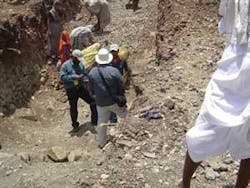Technology developed by the oil and gas industry to locate and extract oil and natural gas from below the earth’s surface is now being adapted for humanitarian purposes.
The revamped application, in this instance, was fueled by a devastating natural event: the Asian Tsunami, or Boxing Day Tsunami, that followed the Indian Ocean earthquake in December 2004. The massive deadly wave struck the coastlines of Indonesia, Sri Lanka, India, and Thailand, as well as other more-distant locations, killing thousands of people and injuring and displacing thousands of others.
Shortly after the disaster, Craig Beasley, then-president of the Society of Exploration Geophysicists (SEG), summoned a call to action to SEG’s membership, urging them to help, stating, “We have a significant contribution to make as geophysicists.”
In early 2008, SEG Foundation, a trust formed by SEG to provide scholarships for students of geophysics, established a program called Geoscientists Without Borders (GWB). With a $1 million funding commitment from Schlumberger (and with further investment since provided by Australia’s Santos Ltd.), the program’s mission statement is straightforward: “Connect universities and industries with communities in need through projects using applied geophysics to benefit people and the environment around the world.”
First projects announced
Last month, GWB revealed that India and Thailand would be the sites for the first two projects sponsored by the GWB program.
Hydrogeophysics will play a major role in both project sites, SEG reported, adding, “Joining universities and their students with communities in two foreign countries, the projects demonstrate the useful and often critical use of geophysics to assist communities with significant needs for such basic resources as fresh water.”
One of the first projects will address the severe water crisis in rural India, SEG said. Clemson University will partner with the Foundation for Ecological Security (FES), an Indian nonprofit organization, to use electromagnetic induction to map soil moisture and shallow aquifers in the Salri watershed in India’s Madhya Pradesh state.
“The scarcity of fresh water is a longstanding problem in central India that impacts the health, productivity, and quality of life for millions of people,” project organizers said. Even though rainfall for the area is usually 45-60 in./year, they said, most of it falls in only 3 months of the year. “The goal of this project is to increase the water supply through water capture, storage, and usage management,” they said.
Led by Stephen Moysey of Clemson University and Rangoori Ravindranath of FES, GWB will provide tools and knowledge that will assist villagers in making water management decisions that will favorably impact water supply throughout the year, SEG said.
Work in Thailand
In Chiang Mai, northern Thailand, SEG reported that three distinct humanitarian efforts under one project are planned that will “mitigate earthquake hazards, address water quality issues, and preserve cultural heritage through archaeological mapping.”
GWB will use seismic, ground-penetrating radar, electrical, gravity, and magnetic methods to address geotechnical issues. Boise State University (BSU) will work in partnership with Chiang Mai University (CMU) to “advance humanitarian geophysics in Southeast Asia through a student-based approach, by teaching students geophysical skills that can be used in their home regions,” SEG said.
“Undergraduate and graduate students, with the help of professionals and teachers, will gain hands-on experience with geophysical data acquisition, processing and interpretation, creating reports that address local environmental and engineering problems,” SEG said.
Leading the effort are Lee Liberty and Kasper van Wijk of BSU, and Spencer Wood (retired from BSU), Fongsaward Singharajwarapan, and Siriporn Chaisri of CMU.


